March is Women's History Month!
Our recommendations for "Heroes" this month are "Heroines" because we're celebrating Women's History month! Take some time to learn about the trail-blazers and female movers and shakers who have made our world a better place.
New and Noteworthy
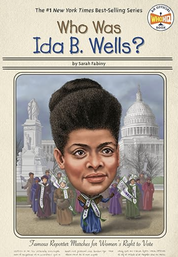
Who Was Ida B. Wells? Sarah Fabiny. Illustrated by Ted Hammond. Penguin Workshop, 2020. (3-6)
Part of the Who Was series, this is a slim paperback for older children on the remarkable life of Ida B. Wells, complete with many of the vivid episodes from her life—her early childhood education thanks to her parents' insistence on it, her aunt letting down the hems of her dresses so she could appear older when teaching school to support her siblings, her writing and editing work, her refusal to leave the ladies' car on the train despite the racism of her time, and more. More appropriate for older kids because of subject matter, but also because this is a slim chapter book. Accompanied by no-frills but still evocative black-and-white illustrations.
Part of the Who Was series, this is a slim paperback for older children on the remarkable life of Ida B. Wells, complete with many of the vivid episodes from her life—her early childhood education thanks to her parents' insistence on it, her aunt letting down the hems of her dresses so she could appear older when teaching school to support her siblings, her writing and editing work, her refusal to leave the ladies' car on the train despite the racism of her time, and more. More appropriate for older kids because of subject matter, but also because this is a slim chapter book. Accompanied by no-frills but still evocative black-and-white illustrations.
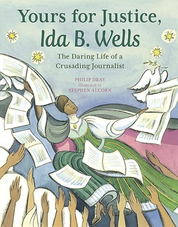
Yours for Justice, Ida B. Wells. Philip Dray. Illustrated by Stephen Alcorn. Peachtree, 2021. (5-6) A powerful tale of unflinching courage in the face of injustice. This book tells the story of Ida B. Wells' life, from being born into slavery, to her first teaching job to support her orphaned younger siblings, to her passionate fight against lynchings as an adult, sparked by the murder of her friend Tom Moss. This text-heavy book accompanied by stylized, lyrical illustrations will engage older children and adults; the heavy subject matter makes it inappropriate for younger kids. Ends on her powerful quotation, "Truth is mighty and will prevail."
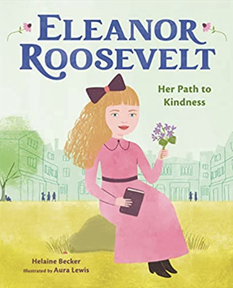
Eleanor Roosevelt: Her Path to Kindness. Helaine Becker. Illustrated by Aura Lewis. Christy Ottaviano Books, 2023. (K-2) Courage, Compassion, Love of Country, Women's History Month.
This thoughtfully-told and beautifully-illustrated book tells the story of a young Eleanor Roosevelt who faced trauma as a young child but came through it to become the brave, gracious First Lady of the United States. Without glossing over the details of a difficult childhood, this book is still appropriate for young children because of its gentle telling of the story and emphasis on Eleanor's bravery and empathy for others. As she says, "Courage is more exhilarating than fear and in the long run it is easier." A more thorough biography at the end gives more details for teachers and older children.
This thoughtfully-told and beautifully-illustrated book tells the story of a young Eleanor Roosevelt who faced trauma as a young child but came through it to become the brave, gracious First Lady of the United States. Without glossing over the details of a difficult childhood, this book is still appropriate for young children because of its gentle telling of the story and emphasis on Eleanor's bravery and empathy for others. As she says, "Courage is more exhilarating than fear and in the long run it is easier." A more thorough biography at the end gives more details for teachers and older children.

The Fire of Stars: The Life and Brilliance of the Woman Who Discovered What Stars Are Made Of. By Kirsten W. Larson. Chronicle Books, 2023. (K-3) Women's History Month, Wonder, Perseverance.
The whimsically-illustrated story of astronomer and astrophysicist Cecilia Payne is lyrically told, and tells the story of her life in parallel with a scientific narrative about the birth of a star. Before Payne, no one knew exactly what stars were made of, what gas burns at the heart of stars. Despite the fact that women astronomers were rare at the time of her work (she made her great discovery at age 25 in 1925), she diligently stuck to her work and made great strides. Bonus material at the end tells more of Payne's story and narrates the birth of a star in panels. (Catholic schools should be aware that one spread portrays Payne's experience with religious sisters at a school in a negative light.)
The whimsically-illustrated story of astronomer and astrophysicist Cecilia Payne is lyrically told, and tells the story of her life in parallel with a scientific narrative about the birth of a star. Before Payne, no one knew exactly what stars were made of, what gas burns at the heart of stars. Despite the fact that women astronomers were rare at the time of her work (she made her great discovery at age 25 in 1925), she diligently stuck to her work and made great strides. Bonus material at the end tells more of Payne's story and narrates the birth of a star in panels. (Catholic schools should be aware that one spread portrays Payne's experience with religious sisters at a school in a negative light.)
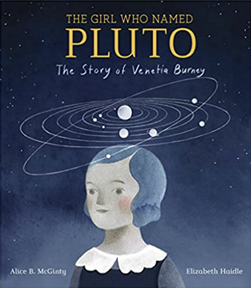
The Girl Who Named Pluto: The Story of Venetia Burney. Alice B. McGinty. Illustrated by Elizabeth Haidle. Schwartz & Wade, 2013. K-4 Wonder.
Inspiring true story of an eleven-year-old British girl whose wonder at the size and majesty of the solar system is sparked by a "planet walk." In 1929, Venetia Burney's teacher takes the class on a measured walk to understand how far the planets were from one another. Shortly thereafter, when Venetia learns yet another planet has been discovered (far beyond then-final Neptune), she knows it must be very dark and very cold. Her studies of Roman mythology trigger a thought: didn't Neptune have a brother named Pluto, who was god of the icy underworld? Why not call it Pluto? she suggests to her grandfather. It just so happens that her grandfather knows someone at the Royal Astronomical Society, who knows someone in Arizona (where the discovery was made). Pluto it is. Whimsy and wonder characterize the illustrations too.
Inspiring true story of an eleven-year-old British girl whose wonder at the size and majesty of the solar system is sparked by a "planet walk." In 1929, Venetia Burney's teacher takes the class on a measured walk to understand how far the planets were from one another. Shortly thereafter, when Venetia learns yet another planet has been discovered (far beyond then-final Neptune), she knows it must be very dark and very cold. Her studies of Roman mythology trigger a thought: didn't Neptune have a brother named Pluto, who was god of the icy underworld? Why not call it Pluto? she suggests to her grandfather. It just so happens that her grandfather knows someone at the Royal Astronomical Society, who knows someone in Arizona (where the discovery was made). Pluto it is. Whimsy and wonder characterize the illustrations too.
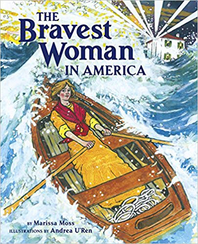
The Bravest Woman in America. Marissa Moss. Illustrated by Andrea U’Ren. Tricycle Press, Berkeley, 2011. (K-3) Responsibility, Courage
Lyrically written, this is the true story of America’s beloved lighthouse keeper: Ida Lewis. As a young girl on the Rhode Island shore, Ida is drawn to the magic of the sea. When her father is named lighthouse keeper of Lime Rock (Newport Harbor), Ida does everything in her power to help him. She learns to row in heavy seas, to check the light, trim the wick, clean the lens, and scan the seas for the signs of boats in trouble. Her father regales her with stories of storms, drowning sailors, and bold rescues. Then her father contracts a disease that cripples him, and before a new lighthouse keeper can be named, sixteen-year-old Ida spots a sailboat floundering in a winter night's storm. The lighthouse is her responsibility now, and she summons her courage to accept the challenge, rescuing four boys whose boat has pitched. Ida remained as lighthouse keeper on Lime Rock for thirty-nine years and is credited with numerous rescues. Bold and vibrant illustrations.
Lyrically written, this is the true story of America’s beloved lighthouse keeper: Ida Lewis. As a young girl on the Rhode Island shore, Ida is drawn to the magic of the sea. When her father is named lighthouse keeper of Lime Rock (Newport Harbor), Ida does everything in her power to help him. She learns to row in heavy seas, to check the light, trim the wick, clean the lens, and scan the seas for the signs of boats in trouble. Her father regales her with stories of storms, drowning sailors, and bold rescues. Then her father contracts a disease that cripples him, and before a new lighthouse keeper can be named, sixteen-year-old Ida spots a sailboat floundering in a winter night's storm. The lighthouse is her responsibility now, and she summons her courage to accept the challenge, rescuing four boys whose boat has pitched. Ida remained as lighthouse keeper on Lime Rock for thirty-nine years and is credited with numerous rescues. Bold and vibrant illustrations.
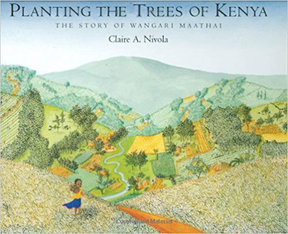
Planting the Trees of Kenya: The Story of Wangari Maathai.
Claire Nivola. Frances Foster Books, 2008.(K-3)
Stewardship, Hope, Lives to Learn From
A beautifully illustrated and inspiring biography of 2004 Nobel Prize winner Wangari Maathai, who led Kenya’s “Green Belt” movement. Born and raised in the hills of central Kenya, Wangari treasured the richness and beauty of her land. She went off to study biology in the United States (in 1960) and seven years later returned to her homeland to find it largely deforested. Maathai led a movement of Kenyan women to replant trees and restore not simply the stripped land, but the relationship between the land and its people. She was fabulously successful, and was awarded the Nobel Prize for her efforts. This is a stunning book about a woman determined to make the world better place – one tree and one woman at a time.
Claire Nivola. Frances Foster Books, 2008.(K-3)
Stewardship, Hope, Lives to Learn From
A beautifully illustrated and inspiring biography of 2004 Nobel Prize winner Wangari Maathai, who led Kenya’s “Green Belt” movement. Born and raised in the hills of central Kenya, Wangari treasured the richness and beauty of her land. She went off to study biology in the United States (in 1960) and seven years later returned to her homeland to find it largely deforested. Maathai led a movement of Kenyan women to replant trees and restore not simply the stripped land, but the relationship between the land and its people. She was fabulously successful, and was awarded the Nobel Prize for her efforts. This is a stunning book about a woman determined to make the world better place – one tree and one woman at a time.

On The Wings of Words: The Extraordinary Life of Emily Dickinson. Jennifer Berne. Illustrated by Becca Stadlander. Chronicle Books, 2020. (K-3) Wonder, Lives to Learn From, Women’s History Month
Lyrically told with whimsical folk art illustrations, this biography of poet Emily Dickinson is a joy. Each page includes snippets of her poetry that express wonder at the world and the small things in life. The illustrations come from historical images and are inspired by Emily’s work. We follow her from her childhood love affair with nature through adult times of trial, but like the butterflies that flutter through its pages, Dickinson lifts and soars.
Lyrically told with whimsical folk art illustrations, this biography of poet Emily Dickinson is a joy. Each page includes snippets of her poetry that express wonder at the world and the small things in life. The illustrations come from historical images and are inspired by Emily’s work. We follow her from her childhood love affair with nature through adult times of trial, but like the butterflies that flutter through its pages, Dickinson lifts and soars.
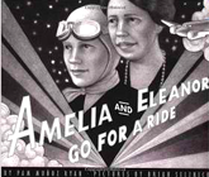
Amelia and Eleanor Go for a Ride. Pam Munoz Ryan.
Illustrated by Brian Selznick. Scholastic, 1999. (K-3)Lives to Learn From
Determination, mettle, and true grit characterize both Amelia Earhart and Eleanor Roosevelt, who were good friends. One night the nation’s First Lady invited the First Lady of the Skies to dinner at the White House. This is the true story of their thrilling after-dinner getaway.
Illustrated by Brian Selznick. Scholastic, 1999. (K-3)Lives to Learn From
Determination, mettle, and true grit characterize both Amelia Earhart and Eleanor Roosevelt, who were good friends. One night the nation’s First Lady invited the First Lady of the Skies to dinner at the White House. This is the true story of their thrilling after-dinner getaway.
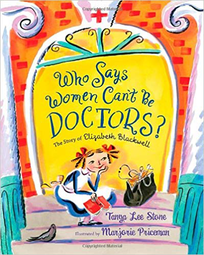
Who Says Women Can’t Be Doctors? The Story of Elizabeth Blackwell. *
Tanya Lee Stone. Illustrated by Marjorie Priceman. Henry Holt, 2013. (K-3)
A snappy biography of the feisty girl, who became the nation’s first female doctor. In the 1840s “lady-doctors” were non-existent in the U.S., but one of Elizabeth Blackwell’s dying friends confided her desire for one. Elizabeth, moved by her friend’s plight and not accustomed to taking “no” for an answer, saw a need, studied for Medical school, and was accepted (as a joke). Elizabeth didn’t see the humor: she enrolled, completed the course, and graduated with top honors. Dr. Blackwell opened a hospital for the poor and orphaned in New York City, paved the way for many more women in medicine. Fast-paced and delightfully rendered account of a woman who was not afraid to plow new ground.*Available on Epic!
Tanya Lee Stone. Illustrated by Marjorie Priceman. Henry Holt, 2013. (K-3)
A snappy biography of the feisty girl, who became the nation’s first female doctor. In the 1840s “lady-doctors” were non-existent in the U.S., but one of Elizabeth Blackwell’s dying friends confided her desire for one. Elizabeth, moved by her friend’s plight and not accustomed to taking “no” for an answer, saw a need, studied for Medical school, and was accepted (as a joke). Elizabeth didn’t see the humor: she enrolled, completed the course, and graduated with top honors. Dr. Blackwell opened a hospital for the poor and orphaned in New York City, paved the way for many more women in medicine. Fast-paced and delightfully rendered account of a woman who was not afraid to plow new ground.*Available on Epic!
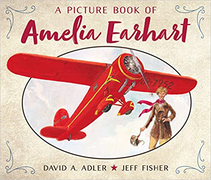
A Picture book of Amelia Earhart. David Adler. Illustrated by Jeff Fisher. Holiday House, 2018. K-2 Courage, Perseverance, WHM; on Epic!
An intriguing biography of Amelia Earhart, a woman of many firsts in aviation. A maverick from her youth, twenty-four-year-old Amelia fell in love with flight in 1920, when she took her first ride at an airshow. She bought her first plane a year later. The first woman to fly solo across the Atlantic, she later became the first person to cross the Pacific from Hawaii to California. Her flying was risky, but Amelia loved a challenge and knew that much would be gained from her efforts. Adler's writing is not lyrical, but the story and the illustrations capture the imagination.
An intriguing biography of Amelia Earhart, a woman of many firsts in aviation. A maverick from her youth, twenty-four-year-old Amelia fell in love with flight in 1920, when she took her first ride at an airshow. She bought her first plane a year later. The first woman to fly solo across the Atlantic, she later became the first person to cross the Pacific from Hawaii to California. Her flying was risky, but Amelia loved a challenge and knew that much would be gained from her efforts. Adler's writing is not lyrical, but the story and the illustrations capture the imagination.
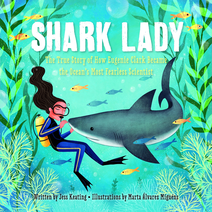
Shark Lady.* Jess Keating. Illustrated by Marta Alvarez Miguens. Sourcebooks, 2017.(K-4) Wonder, Lives to Learn From
As a little girl, Eugenie Clark visited the aquarium and became fascinated with sharks. Others saw them as “ugly and scary,” but their silvery fins and graceful glide fascinated Eugenie. Though many people tried to discourage her from following her dream, she was determined to make them her life’s work—studying hard, and eventually exploring the oceans and seas for sharks. This female pioneer in marine biology was fearless, and the book teaches us much about her discoveries. Lovely text and bright illustrations convey the excitement and beauty that Eugenie experienced while diving.*Available on Epic!
As a little girl, Eugenie Clark visited the aquarium and became fascinated with sharks. Others saw them as “ugly and scary,” but their silvery fins and graceful glide fascinated Eugenie. Though many people tried to discourage her from following her dream, she was determined to make them her life’s work—studying hard, and eventually exploring the oceans and seas for sharks. This female pioneer in marine biology was fearless, and the book teaches us much about her discoveries. Lovely text and bright illustrations convey the excitement and beauty that Eugenie experienced while diving.*Available on Epic!
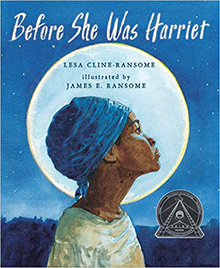
Before She Was Harriet. * Lesa Cline-Ransome.
Illustrated by James E. Ransome Holiday House, 2017. (K-3)
Courage, Service
A poetic review of the very full life of Harriet Tubman. Engrossing full-page watercolors draw you into the amazing accomplishments of Harriet’s life - suffragette, nurse, Union spy as well as conductor of the Underground Railroad. The text is sparse, but lyrical and will lead to many questions and discussion of Harriet’s courage and sense of purpose. Excellent with the second grade Core Knowledge unit on the Civil War.*Available on Epic!
Illustrated by James E. Ransome Holiday House, 2017. (K-3)
Courage, Service
A poetic review of the very full life of Harriet Tubman. Engrossing full-page watercolors draw you into the amazing accomplishments of Harriet’s life - suffragette, nurse, Union spy as well as conductor of the Underground Railroad. The text is sparse, but lyrical and will lead to many questions and discussion of Harriet’s courage and sense of purpose. Excellent with the second grade Core Knowledge unit on the Civil War.*Available on Epic!
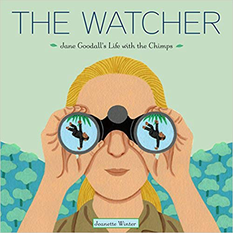
The Watcher. Jane Goodall’s Life With the Chimps. Jeanette Winter. Schwartz Wade Books, 2011. (K-3) Lives to Learn From, Diligence, Stewardship, Courage, Hope
A simple biography of Jane Goodall’s amazing life with her beloved chimps. A quiet and keen observer from an early age, Jane loved animals and knew that she wanted to study them in the wild. She worked hard to make that happen, eventually moving from London to the Gombe forest in Tanzania to study chimpanzees. The chimps became accustomed to "the white ape" among them (the phrase is Jane's self-description). Goodall spent many years studying the primates, writing about them, and educating the world about their habits. When deforestation threatened the forests in which they lived, Jane realized she could be a voice for the chimps. At age 85, she continues to educate many about protecting animals, their habitat, and the planet.
A simple biography of Jane Goodall’s amazing life with her beloved chimps. A quiet and keen observer from an early age, Jane loved animals and knew that she wanted to study them in the wild. She worked hard to make that happen, eventually moving from London to the Gombe forest in Tanzania to study chimpanzees. The chimps became accustomed to "the white ape" among them (the phrase is Jane's self-description). Goodall spent many years studying the primates, writing about them, and educating the world about their habits. When deforestation threatened the forests in which they lived, Jane realized she could be a voice for the chimps. At age 85, she continues to educate many about protecting animals, their habitat, and the planet.

Emma’s Poem: The Voice of the Statue of Liberty. Linda Glaser.
Illustrated by Claire A. Nivola. HMH Books, 2010. (K-4)Love of Country
Born into privilege in New York City, Emma Lazarus wanted for nothing in her youth, but she had a big heart. When she visited Ward’s Island in New York City in the 1880s (an immigrant detention and treatment center), she was touched by the plight of impoverished immigrants coming to American shores. She helped them learn English and find jobs, but eventually she answered the call to write a poem to raise money for the pedestal on which to place the Statue of Liberty. Emma Lazarus defied the common wisdom that women shouldn’t write and that the destitute immigrants were a threat to the nation. Her poem “The New Colossus,” with its call to “send me your poor, your tired, your huddled masses yearning to breathe free” became the voice of the Statue of Liberty, emblazoned at its base. The words have stirred American hearts and imaginations ever since.
Illustrated by Claire A. Nivola. HMH Books, 2010. (K-4)Love of Country
Born into privilege in New York City, Emma Lazarus wanted for nothing in her youth, but she had a big heart. When she visited Ward’s Island in New York City in the 1880s (an immigrant detention and treatment center), she was touched by the plight of impoverished immigrants coming to American shores. She helped them learn English and find jobs, but eventually she answered the call to write a poem to raise money for the pedestal on which to place the Statue of Liberty. Emma Lazarus defied the common wisdom that women shouldn’t write and that the destitute immigrants were a threat to the nation. Her poem “The New Colossus,” with its call to “send me your poor, your tired, your huddled masses yearning to breathe free” became the voice of the Statue of Liberty, emblazoned at its base. The words have stirred American hearts and imaginations ever since.
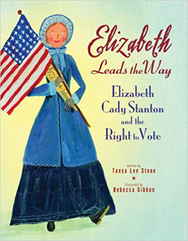
Elizabeth Leads the Way: Elizabeth Cady Stanton and the Right to Vote.
Tanya Lee Stone. Illustrated by Rebecca Gibbon. Square Fish, 2010.
(K-2) Justice, Civic Courage
Charmingly written in a very simple style, this book takes us back to a time when women in the United States (and most of the world) could not vote, inherit property, and basically, did not have equality of rights. Stone gives us a spunky heroine who championed woman suffrage, and led the way to a more just nation. The illustrations are lively (though a bit cartoonish) and the text sings.
Tanya Lee Stone. Illustrated by Rebecca Gibbon. Square Fish, 2010.
(K-2) Justice, Civic Courage
Charmingly written in a very simple style, this book takes us back to a time when women in the United States (and most of the world) could not vote, inherit property, and basically, did not have equality of rights. Stone gives us a spunky heroine who championed woman suffrage, and led the way to a more just nation. The illustrations are lively (though a bit cartoonish) and the text sings.
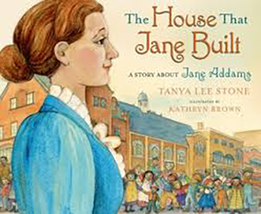
The House that Jane Built: A Story about Jane Addams.*
Tanya Lee Stone. Illustrated by Kathryn Brown. Henry Holt & Co., 2015. (K-3) Service, Generosity, Compassion
Why would a wealthy young woman abandon a life of privilege and pour her resources and herself into clothing, feeding and educating the poor? Because even as a young child, Jane had eyes to see those in need, and a desire to serve them. This is an inspiring, beautifully written portrayal of the life of Jane Addams, founder of Hull House, which served Chicago’s destitute and immigrant communities at the turn of the century. Muted watercolors perfectly portray the period. *This story is available on Storyline Online.
Tanya Lee Stone. Illustrated by Kathryn Brown. Henry Holt & Co., 2015. (K-3) Service, Generosity, Compassion
Why would a wealthy young woman abandon a life of privilege and pour her resources and herself into clothing, feeding and educating the poor? Because even as a young child, Jane had eyes to see those in need, and a desire to serve them. This is an inspiring, beautifully written portrayal of the life of Jane Addams, founder of Hull House, which served Chicago’s destitute and immigrant communities at the turn of the century. Muted watercolors perfectly portray the period. *This story is available on Storyline Online.

The World is Not a Rectangle. Jeanette Winter. Beach Lane Books, 2017. (K-5) Perseverance, Wonder, Lives to Learn From
Another triumph for Jeanette Winter with this inspiring picture book biography of Iraqi-born architect Zaha Hadid. Growing up near windswept desert and the Euphrates river, Zaha was acutely aware of swirling forms and patterns in nature. “She has ideas." After she studied architecture in London, she started her own firm. Her designs were unlike traditional buildings – resembling instead sand dunes and marsh grasses. It took a while for people to understand her vision. But slowly her studio grew from one person to over four-hundred. She has been asked to design buildings around the world. Zaha is the first woman ever to receive both the Pritzker Prize and the Royal Gold Medal (Architecture awards). Jeanette Winter playfully captures Zaha’s vision in her colorful illustrations that flow from page to page, much like the architecture Zaha designed. This wonderful book encourages kids to truly "see" the world around them and pursue their dreams, no matter how unconventional. Fine first grade Core Knowledge tie-in with Ancient Mesopotamia unit (Zaha visualizes ancient Babylon with its ziggurats!)
Another triumph for Jeanette Winter with this inspiring picture book biography of Iraqi-born architect Zaha Hadid. Growing up near windswept desert and the Euphrates river, Zaha was acutely aware of swirling forms and patterns in nature. “She has ideas." After she studied architecture in London, she started her own firm. Her designs were unlike traditional buildings – resembling instead sand dunes and marsh grasses. It took a while for people to understand her vision. But slowly her studio grew from one person to over four-hundred. She has been asked to design buildings around the world. Zaha is the first woman ever to receive both the Pritzker Prize and the Royal Gold Medal (Architecture awards). Jeanette Winter playfully captures Zaha’s vision in her colorful illustrations that flow from page to page, much like the architecture Zaha designed. This wonderful book encourages kids to truly "see" the world around them and pursue their dreams, no matter how unconventional. Fine first grade Core Knowledge tie-in with Ancient Mesopotamia unit (Zaha visualizes ancient Babylon with its ziggurats!)

Queen of Physics: How Wu Chien Shiung Helped Unlock the Secrets of the Atom. Teresa Robeson. Illustrated by Rebecca Huang. Union Square Kids, 2019. (1-3) Diligence, Wonder, Perseverance, Courage, Women's History Month
Wu Chien Shiung was born in China in 1912 to an unusual family: parents who believed that girls had the same right to learn as boys, and who started a school to teach girls. The daughter's name meant “courageous hero.” And she indeed grew up to do great things, eventually traveling to Berkeley, California to do groundbreaking work in nuclear physics. As a woman of Asian descent in the 1930s, Wu Chien had an uphill battle in her field, but was undeterred. Geared to younger kids, this book does a good job of explaining Wu’s work in a way that everyone can understand, but the subject material and glossary at the end ensure that adults and older kids will also learn a lot from this book.
Wu Chien Shiung was born in China in 1912 to an unusual family: parents who believed that girls had the same right to learn as boys, and who started a school to teach girls. The daughter's name meant “courageous hero.” And she indeed grew up to do great things, eventually traveling to Berkeley, California to do groundbreaking work in nuclear physics. As a woman of Asian descent in the 1930s, Wu Chien had an uphill battle in her field, but was undeterred. Geared to younger kids, this book does a good job of explaining Wu’s work in a way that everyone can understand, but the subject material and glossary at the end ensure that adults and older kids will also learn a lot from this book.
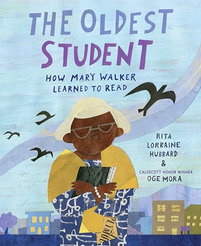
The Oldest Student: How Mary Walker Learned to Read. Rita Lorraine Hubbard. Illustrated by Oge Mora. (1-4) Perseverance, Patience, Diligence, Courage, Hope, Women's History Month.
Cutout-style illustrations from Caldecott-winning Oge Mora accompany this tale of Mary Walker, born into slavery in 1848, who learned to read in 1963—at the age of 116. A striking story about the power of perseverance against all odds and the extraordinarily long life of a woman who saw both the Civil War and the Civil Rights Movement. An inspiring and humbling story that will help both children and adults put their own difficulties into perspective—and remind children who may be struggling to read that there is always plenty of time.
Cutout-style illustrations from Caldecott-winning Oge Mora accompany this tale of Mary Walker, born into slavery in 1848, who learned to read in 1963—at the age of 116. A striking story about the power of perseverance against all odds and the extraordinarily long life of a woman who saw both the Civil War and the Civil Rights Movement. An inspiring and humbling story that will help both children and adults put their own difficulties into perspective—and remind children who may be struggling to read that there is always plenty of time.

What Miss Mitchell Saw. Hayley Barrett. Illustrated by Diana Sudyka. Beach Lane Books, 2019. (2-4) Wonder, Diligence, Women’s History Month.
Nantucket-born Maria Mitchell grows up enthralled by the stars, and the sky is her sea. First as a teacher and then as a librarian, she keeps her sense of wonder alive, scanning the skies nightly and naming all the heavenly bodies she sees there. Then, on an October evening in 1847, she sees something never before seen—a new comet. Will Miss Mitchell get the credit for sighting the comet first, even though it takes so long for her letter to reach Europe that a Vatican astronomer claims the comet in the meantime? Yes, she will! Beguiling illustrations of the night sky, an informative fact section at the end, and the distinctive influence of Mitchell’s Quaker upbringing will interest both younger and older kids.
Nantucket-born Maria Mitchell grows up enthralled by the stars, and the sky is her sea. First as a teacher and then as a librarian, she keeps her sense of wonder alive, scanning the skies nightly and naming all the heavenly bodies she sees there. Then, on an October evening in 1847, she sees something never before seen—a new comet. Will Miss Mitchell get the credit for sighting the comet first, even though it takes so long for her letter to reach Europe that a Vatican astronomer claims the comet in the meantime? Yes, she will! Beguiling illustrations of the night sky, an informative fact section at the end, and the distinctive influence of Mitchell’s Quaker upbringing will interest both younger and older kids.
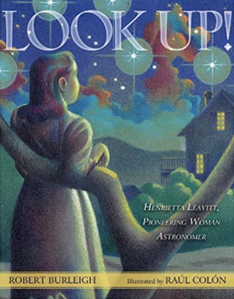
Look Up!: Henrietta Leavitt, Pioneering Woman Astronomer. Robert Burleigh. Illustrated by Raúl Colón. Simon & Schuster/Paula Wiseman Books, 2013. 2-4. Wonder, Diligence, Perseverance. "She wanted to know more about the wonderful bigness of all she saw." Henrietta Leavitt, who studied astronomy at Radcliffe in the 1890s, took an entry-level job at Harvard's Observatory, measuring positions of stars so that she could eventually get a chance to study the heavens. She revolutionized the understanding of the size of the universe with her approach to measuring large distances in space. Williamina Fleming, brought to life in Kathryn Lasky's She Caught the Light, was her contemporary and colleague. Both women were initially hired as "computers" (engaged to simply to compute results) but became scientists in their own right, making major discoveries in the wondrous field of astronomy. Wonder-fully illustrated too.
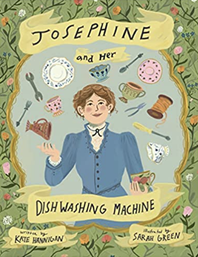
Josephine and her Dishwashing Machine. Kate Hannigan. Illustrated by Sarah Green. Calkins Creek, 2023. (2-5) Diligence, Perseverance, Women's History Month
The true and well told story of Josephine Garis Cochrane, inventor of the automatic dishwasher. (America's households thank you!) She grew up in a family of engineers, and found her own task of washing the crockery less than rewarding, resolving to build a machine to do it quickly and well. She tinkered, persevered, failed more than once, and then she succeeded! In 1886, she patented the first commercial dishwasher (under J.G. Cochrane), and exhibited it in 1893 at the Columbian Exhibition World's Fair in Chicago. Eat your heart out, Thomas Edison! Don't miss this charming read about an unknown heroine in the "Age of Invention," who went on to become a very successful entrepreneur. Backmatter includes information on sixteen other women inventors of the era. Works well with fourth grade Second Industrial Revolution unit in Core Knowledge.
The true and well told story of Josephine Garis Cochrane, inventor of the automatic dishwasher. (America's households thank you!) She grew up in a family of engineers, and found her own task of washing the crockery less than rewarding, resolving to build a machine to do it quickly and well. She tinkered, persevered, failed more than once, and then she succeeded! In 1886, she patented the first commercial dishwasher (under J.G. Cochrane), and exhibited it in 1893 at the Columbian Exhibition World's Fair in Chicago. Eat your heart out, Thomas Edison! Don't miss this charming read about an unknown heroine in the "Age of Invention," who went on to become a very successful entrepreneur. Backmatter includes information on sixteen other women inventors of the era. Works well with fourth grade Second Industrial Revolution unit in Core Knowledge.
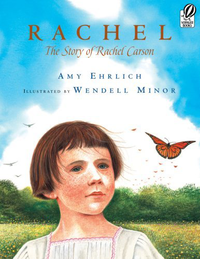
Rachel. The Story of Rachel Carson. Amy Ehrlich.
Illustrated by Wendell Minor. Harcourt Books, 2008. (2-5) Stewardship, Lives to Learn From
Gorgeous illustrations of the natural world highlight this thoughtful biography of Rachel Carson, who from an early age loved writing and nature. As an undergraduate, Rachel intended to become a writer, but changed her major to biology after a particularly intriguing course. Her adult life married her twin passions, and as the author of Silent Spring, Carson became an early champion of the environment, urging caution in the use of pesticides and DDT. The illustrations are stunning and the rich, lyrically told story will inspire young people. (NB: The book needed a better content editor: sentence structure on one page suggests that whales are fish and that plankton density is higher than it is, but our judgment is in favor of the book.)
Illustrated by Wendell Minor. Harcourt Books, 2008. (2-5) Stewardship, Lives to Learn From
Gorgeous illustrations of the natural world highlight this thoughtful biography of Rachel Carson, who from an early age loved writing and nature. As an undergraduate, Rachel intended to become a writer, but changed her major to biology after a particularly intriguing course. Her adult life married her twin passions, and as the author of Silent Spring, Carson became an early champion of the environment, urging caution in the use of pesticides and DDT. The illustrations are stunning and the rich, lyrically told story will inspire young people. (NB: The book needed a better content editor: sentence structure on one page suggests that whales are fish and that plankton density is higher than it is, but our judgment is in favor of the book.)
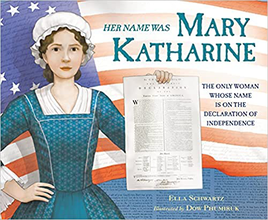
Her Name was Mary Katherine: The Only Woman Whose Name is on the Declaration of Independence. Ella Schwartz. Illustrated by Dow Phumiruk. (Christy Ottaviano Books, 2022) 2-5 Courage, Perseverance, Love of Country
This is a little known true story of (as the subtitle says) "the only woman whose name is on the Declaration of Independence." In eighteenth century New England, Mary Katherine Goddard was raised by parents who believed in education for girls as well as boys. When her brother William proved himself an unreliable owner of the Providence print shop that supported the family, Mary Katherine stepped in. At the age when most young colonial women were contemplating marriage, she was learning typeset and press operation. By 1774, she was in Baltimore, and had taken over her brother's Maryland Journal. Guess who printed the Declaration of Independence for the Second Continental Congress, and (at a time when the action was treasonous to the Crown) was bold enough to insert her loyalty to the new cause at the bottom. "Printed by Mary Katherine Goddard." A story of courage, enterprise, and a woman who persevered.
This is a little known true story of (as the subtitle says) "the only woman whose name is on the Declaration of Independence." In eighteenth century New England, Mary Katherine Goddard was raised by parents who believed in education for girls as well as boys. When her brother William proved himself an unreliable owner of the Providence print shop that supported the family, Mary Katherine stepped in. At the age when most young colonial women were contemplating marriage, she was learning typeset and press operation. By 1774, she was in Baltimore, and had taken over her brother's Maryland Journal. Guess who printed the Declaration of Independence for the Second Continental Congress, and (at a time when the action was treasonous to the Crown) was bold enough to insert her loyalty to the new cause at the bottom. "Printed by Mary Katherine Goddard." A story of courage, enterprise, and a woman who persevered.
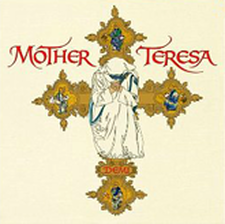
Mother Teresa. Demi.
Margaret K. McElderry, 2010. (2-5)Compassion, Mercy
A startlingly beautiful picture-book biography of the woman whose life came to be synonymous with compassion and service of the poor. Demi, who has written about and illustrated the lives of many religious figures, uses gold ink, simple lines, vivid colors, and intricate borders to tell the life story of the little nun who founded an order of sisters to helping India’s sick and dying. Demi situates Mother Teresa’s work with the poorest of the poor in the context of her deep faith. This is a wonderful introduction to one of the great human beings of modern times.
Margaret K. McElderry, 2010. (2-5)Compassion, Mercy
A startlingly beautiful picture-book biography of the woman whose life came to be synonymous with compassion and service of the poor. Demi, who has written about and illustrated the lives of many religious figures, uses gold ink, simple lines, vivid colors, and intricate borders to tell the life story of the little nun who founded an order of sisters to helping India’s sick and dying. Demi situates Mother Teresa’s work with the poorest of the poor in the context of her deep faith. This is a wonderful introduction to one of the great human beings of modern times.
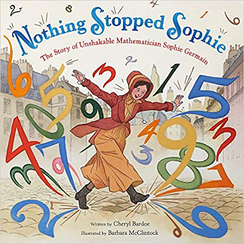
Nothing Stopped Sophie. The Unshakable Mathematician Sophie Germain. Cheryl Bardoe. Illustrated by Barbara McClintock. Little Brown Books, 2018. (2-6) Perseverance, Intellectual Wonder
Lyrically written and vibrantly illustrated, this is the true story of eighteenth century French mathematician Sophie Germain. At a time when girls were expected to excel in embroidery and the piano, little Sophie knew she had a gift for numbers. "Telling Sophie not to think about math was like telling a bird not to soar," Bardoe writes. But no one would take a female math student seriously, so as she matured, Sophie Germain began to mail in homework assignments to a leading professor signed, "Monsieur Le Blanc." Finally, Professor LaGrange, mightily impressed with the student he'd never met, came to seek him out -- only to find he was a HER. The book shows Sophie's perseverance not simply in breaking gender barriers, but in solving difficult problems that involved failed first iterations and re-thinking. In 1816 Sofie Germain became the first woman to win a grand prize from the Royal Academy of Sciences, for her work predicting vibration patterns. This mathematical understanding made it possible to build the Eiffel Tower in Paris and erect lengthy bridges all over the world. A lovely exemplar of "try, try again."
Lyrically written and vibrantly illustrated, this is the true story of eighteenth century French mathematician Sophie Germain. At a time when girls were expected to excel in embroidery and the piano, little Sophie knew she had a gift for numbers. "Telling Sophie not to think about math was like telling a bird not to soar," Bardoe writes. But no one would take a female math student seriously, so as she matured, Sophie Germain began to mail in homework assignments to a leading professor signed, "Monsieur Le Blanc." Finally, Professor LaGrange, mightily impressed with the student he'd never met, came to seek him out -- only to find he was a HER. The book shows Sophie's perseverance not simply in breaking gender barriers, but in solving difficult problems that involved failed first iterations and re-thinking. In 1816 Sofie Germain became the first woman to win a grand prize from the Royal Academy of Sciences, for her work predicting vibration patterns. This mathematical understanding made it possible to build the Eiffel Tower in Paris and erect lengthy bridges all over the world. A lovely exemplar of "try, try again."
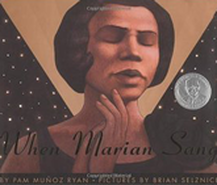
When Marian Sang. Pam Munoz Ryan
Illustrated by Brian Selznick. Scholastic Press, 2002. (2-5)Respect
A splendid picture book biography of Marian Anderson, the early twentieth century African-American singer whose “range of notes caused all the commotion. With one breath she sounded like rain, sprinkling high notes in the morning sun. And with the next she was thunder resounding deep in a dark sky.” This is the story of her gifts and her quest to sing professionally in the face of prejudice in 1920s America. She went overseas, where she became a sensation. Returning to the United States in 1939, Marian was not allowed to sing at (ironically) Constitution Hall, which had a “white performers only” policy. Eleanor Roosevelt intervened, and Marian Anderson sang “My Country ‘tis of Thee” to 75,000 people at the foot of the Lincoln Memorial instead. The lyrics of Marian’s songs (reprinted throughout) underscore her faith and courage in the face of indignity and prejudice.
Illustrated by Brian Selznick. Scholastic Press, 2002. (2-5)Respect
A splendid picture book biography of Marian Anderson, the early twentieth century African-American singer whose “range of notes caused all the commotion. With one breath she sounded like rain, sprinkling high notes in the morning sun. And with the next she was thunder resounding deep in a dark sky.” This is the story of her gifts and her quest to sing professionally in the face of prejudice in 1920s America. She went overseas, where she became a sensation. Returning to the United States in 1939, Marian was not allowed to sing at (ironically) Constitution Hall, which had a “white performers only” policy. Eleanor Roosevelt intervened, and Marian Anderson sang “My Country ‘tis of Thee” to 75,000 people at the foot of the Lincoln Memorial instead. The lyrics of Marian’s songs (reprinted throughout) underscore her faith and courage in the face of indignity and prejudice.
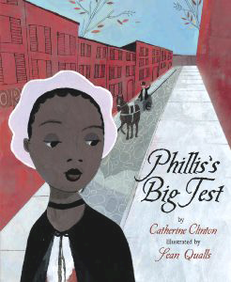
Phillis’s Big Test. Catherine Clinton. Illustrated by Sean Qualls.
HMH Books for Young Readers, 2008. (2-3) Women’s History Month,
Black History Month, Courage, Diligence
Phillis Wheatly was brought to America as a slave when she was seven-years-old. She learned to read and write with the master’s children. She began writing poetry at a young age, and had a gift for it. When she took her poems to be printed in a single volume, the printer refused because he couldn’t believe she had written them. She was asked to appear before a panel of eighteen men, including the Governor and several ministers and poets, to test that she was the author. She passed easily and became the first black woman poet to be published in 1773, and became a free woman shortly thereafter.
HMH Books for Young Readers, 2008. (2-3) Women’s History Month,
Black History Month, Courage, Diligence
Phillis Wheatly was brought to America as a slave when she was seven-years-old. She learned to read and write with the master’s children. She began writing poetry at a young age, and had a gift for it. When she took her poems to be printed in a single volume, the printer refused because he couldn’t believe she had written them. She was asked to appear before a panel of eighteen men, including the Governor and several ministers and poets, to test that she was the author. She passed easily and became the first black woman poet to be published in 1773, and became a free woman shortly thereafter.
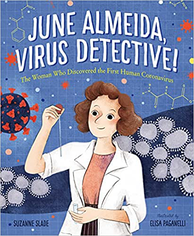
June Almeida, Virus Detective! The Woman Who Discovered the First Human Coronavirus. Suzanne Slade. Illustrated by Elisa Paganelli. Sleeping Bear Press, 2021. (2-6) Diligence, Perseverance, Love of Learning, WHM
The true story of Scottish virologist, June Hart Almeida, who loved science from the time of her youth. The little girl raced to school each day, consumed with curiosity about the workings of nature. Her passion for understanding deepened when her little brother Harry died of disease and "sadness swallowed the family like a deep, dark hole." How could Harry have been saved? June's parents could not afford to send her to college, but she persevered in her passion for science, working first in a hospital lab, learning to use the new electron microscope. A pioneer in virology, she designed a system to identify new viruses and photograph them with the microscope. Eventually, she earned international fame, and a Ph.D. based on her research. A true story of diligence that is enormously relevant for our times.
The true story of Scottish virologist, June Hart Almeida, who loved science from the time of her youth. The little girl raced to school each day, consumed with curiosity about the workings of nature. Her passion for understanding deepened when her little brother Harry died of disease and "sadness swallowed the family like a deep, dark hole." How could Harry have been saved? June's parents could not afford to send her to college, but she persevered in her passion for science, working first in a hospital lab, learning to use the new electron microscope. A pioneer in virology, she designed a system to identify new viruses and photograph them with the microscope. Eventually, she earned international fame, and a Ph.D. based on her research. A true story of diligence that is enormously relevant for our times.
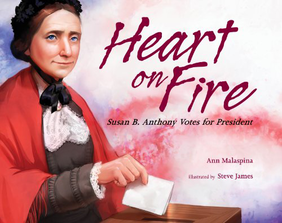
Heart on Fire: Susan B. Anthony Votes for President. Anna Malaspina. Illustrated by Steve James. Albert Whitman & Co., 2012.
(2-4) Courage, Justice
Her entire life was instructive, but this fine picture focuses on Susan B. Anthony's courageous decision to vote for President in 1872 (decades before women had the right to vote) and the judge's infamous verdict of "guilty." A leader in the women's suffrage movement, Anthony defied public ridicule (insults and eggs thrown at her), arrest, and trial, as she led the fight for women's rights. Beautifully illustrated. This volume covers just one courageous incident in her life. For a fuller biography, see the Alexandra Wallner biography featured under Heroes.
(2-4) Courage, Justice
Her entire life was instructive, but this fine picture focuses on Susan B. Anthony's courageous decision to vote for President in 1872 (decades before women had the right to vote) and the judge's infamous verdict of "guilty." A leader in the women's suffrage movement, Anthony defied public ridicule (insults and eggs thrown at her), arrest, and trial, as she led the fight for women's rights. Beautifully illustrated. This volume covers just one courageous incident in her life. For a fuller biography, see the Alexandra Wallner biography featured under Heroes.
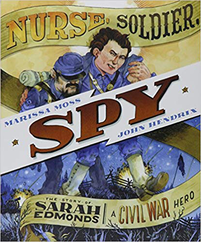
Nurse, Soldier, Spy. The Story of Sarah Edmonds, A Civil War Hero. *
Marissa Moss. Illustrated by John Hendrix. Abrams Books for Young Readers, 2016.(2-5) Courage, Heroism
When Canadian-born Sarah was sixteen, her father insisted she marry an elderly man. Sarah refused and escaped her fate by crossing the border to the United States dressed as a man. She enjoyed the freedom her disguise gave her, and settled in Michigan as "Fred Thompson." When the Civil War broke out, Sarah felt duty bound to serve her new country, joining the Michigan Infantry with her new identity. At first, "Fred" nursed wounded soldiers, but then was asked to spy for the Union Army. Creative in disguise, "Fred" brought valuable information to the generals and developed compassion for the plight of slaves. John Hendrix’s detailed illustrations practically leap off the page. Historical information at the end of the book indicates that hundreds of women chose to follow their brothers and husbands into battle dressed as men! P.S.: Sarah returned to her life as a woman when she contracted malaria and required medical attention. After the war, she married, running a home for disabled veterans and an orphanage for African-American children who had lost their fathers in the war. She also wrote a memoir of her experiences that became a best seller. This book complements the Core Knowledge History Unit in Grade 2 or 5.*Available on Epic!
Marissa Moss. Illustrated by John Hendrix. Abrams Books for Young Readers, 2016.(2-5) Courage, Heroism
When Canadian-born Sarah was sixteen, her father insisted she marry an elderly man. Sarah refused and escaped her fate by crossing the border to the United States dressed as a man. She enjoyed the freedom her disguise gave her, and settled in Michigan as "Fred Thompson." When the Civil War broke out, Sarah felt duty bound to serve her new country, joining the Michigan Infantry with her new identity. At first, "Fred" nursed wounded soldiers, but then was asked to spy for the Union Army. Creative in disguise, "Fred" brought valuable information to the generals and developed compassion for the plight of slaves. John Hendrix’s detailed illustrations practically leap off the page. Historical information at the end of the book indicates that hundreds of women chose to follow their brothers and husbands into battle dressed as men! P.S.: Sarah returned to her life as a woman when she contracted malaria and required medical attention. After the war, she married, running a home for disabled veterans and an orphanage for African-American children who had lost their fathers in the war. She also wrote a memoir of her experiences that became a best seller. This book complements the Core Knowledge History Unit in Grade 2 or 5.*Available on Epic!
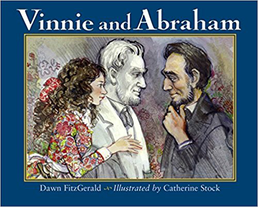
Vinnie and Abraham. Dawn Fitzgerald
Illustrated by Catherine Stock. Charlesbridge, 2009.
(2-5) Perseverance
Inspiring picture-book biography of Vinnie Ream, the self-taught artist and accomplished American sculptress, who never gave up. Born (1847) and raised in the Wisconsin territory, she was admiring of, and eager to sculpt, Abraham Lincoln. When she and her family moved to DC during the Civil War, Vinnie managed to convince the President to sit for her. After Lincoln's assassination, she became (at 18) the youngest artist and first woman to receive a federal commission. She sculpted from marble the Lincoln statue that now stands in the Capitol (statuary hall). The book is a tribute to her persistence, courage to step outside prescribed bounds, and great love for a great man.
Illustrated by Catherine Stock. Charlesbridge, 2009.
(2-5) Perseverance
Inspiring picture-book biography of Vinnie Ream, the self-taught artist and accomplished American sculptress, who never gave up. Born (1847) and raised in the Wisconsin territory, she was admiring of, and eager to sculpt, Abraham Lincoln. When she and her family moved to DC during the Civil War, Vinnie managed to convince the President to sit for her. After Lincoln's assassination, she became (at 18) the youngest artist and first woman to receive a federal commission. She sculpted from marble the Lincoln statue that now stands in the Capitol (statuary hall). The book is a tribute to her persistence, courage to step outside prescribed bounds, and great love for a great man.
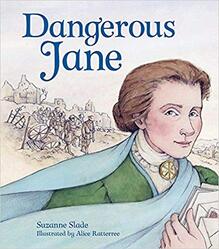
Dangerous Jane.* Suzanne Slade. Illustrated by Alice Ratterree.
Peachtree Publishing, 2017. (2-5) Compassion, Mercy, Courage
The first woman to win the Nobel Peace Prize, Jane Addams had a heart for those in need. She was born to privilege, but lost her mother at age two and endured a debilitating disease as a child. Her father made sure Jane read deeply and was not insulated from the needs of others. Early on, the little girl wondered what she could do to help those in her city who suffered poverty and injustice. As a young woman, she started Chicago's Hull House to assist the immigrant community. She was a study in courage as she continued to take strong stands on hard issues (World War I) and faced lots of public criticism. This is a powerful biography of her life, poetically written and illustrated with evocative water color pen and ink drawings. *Available on Epic!
Peachtree Publishing, 2017. (2-5) Compassion, Mercy, Courage
The first woman to win the Nobel Peace Prize, Jane Addams had a heart for those in need. She was born to privilege, but lost her mother at age two and endured a debilitating disease as a child. Her father made sure Jane read deeply and was not insulated from the needs of others. Early on, the little girl wondered what she could do to help those in her city who suffered poverty and injustice. As a young woman, she started Chicago's Hull House to assist the immigrant community. She was a study in courage as she continued to take strong stands on hard issues (World War I) and faced lots of public criticism. This is a powerful biography of her life, poetically written and illustrated with evocative water color pen and ink drawings. *Available on Epic!
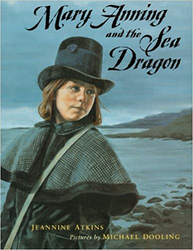
Mary Anning and the Sea Dragon. Jeannine Atkins.
Illustrated by Michael Dooling. Create Space, 2012. (K-5)
In the early 1800s Mary Anning helped her mother support their family after the death of her father. Mary’s father had taught her how to dig in the sand for buried shells and other “curiosities,” we know as “fossils.” She was twelve years old when she began to uncover the remains of an astonishing creature buried in the sand by the cliffs of Regis, England. This is the true story of a young girl whose year of patient toil brought the world its first “ichthyosaur” skeleton. Mary lived long enough to hear the word “dinosaur” coined in 1841.
Illustrated by Michael Dooling. Create Space, 2012. (K-5)
In the early 1800s Mary Anning helped her mother support their family after the death of her father. Mary’s father had taught her how to dig in the sand for buried shells and other “curiosities,” we know as “fossils.” She was twelve years old when she began to uncover the remains of an astonishing creature buried in the sand by the cliffs of Regis, England. This is the true story of a young girl whose year of patient toil brought the world its first “ichthyosaur” skeleton. Mary lived long enough to hear the word “dinosaur” coined in 1841.
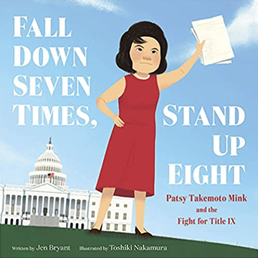
Fall Down Seven Times, Stand Up Eight: Patsy Takemoto Mink and the Fight for Title IX. Jen Bryant. Illustrated by Toshiki Nakamura. Quill Tree Books, 2022. (1-3) Perseverance, Women's History Month
The story of Patsy Mink, the first Asian American woman elected to Congress. Patsy was born on Maui and much influenced by the Japanese proverb which encouraged resilience: "fall down seven times, stand up eight." She had reason to draw strength from it. Though valedictorian in her high school class, she was denied admission to medical school because of her gender. She went on to law school instead (University of Chicago), and made sure that double standard did not persist into the second half of the twentieth century. Patsy learned through many trials to persist, and she helped achieve equality for girls and boys in academics and sports by sponsoring the Title IX bill in the US Congress.
The story of Patsy Mink, the first Asian American woman elected to Congress. Patsy was born on Maui and much influenced by the Japanese proverb which encouraged resilience: "fall down seven times, stand up eight." She had reason to draw strength from it. Though valedictorian in her high school class, she was denied admission to medical school because of her gender. She went on to law school instead (University of Chicago), and made sure that double standard did not persist into the second half of the twentieth century. Patsy learned through many trials to persist, and she helped achieve equality for girls and boys in academics and sports by sponsoring the Title IX bill in the US Congress.
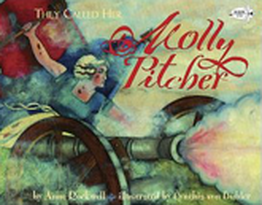
They Called Her Molly Pitcher. Anne Rockwell.
Illustrated by Cynthia von Buhler. Dragonfly Books, 2006.
(2-6) Civic Responsibility, Courage
The only female sergeant in the American Revolutionary army? Probably. This is a vivid recounting of the story of Molly Pitcher, feisty wife of a revolutionary soldier. She accompanied her husband to Valley Forge and with a keen sense of responsibility, helped troops endure the winter there. Molly stayed with them through the blistering summer on the battlefield where she brought water to the wounded (they called “Molly – pitcher!” and she came), and secured her own place in history when she took over the cannon from her wounded husband. Von Buhler’s illustrations are clean and strong, evoking images of American primitivism. The book is a triumph and fills a big gap. (The Core Knowledge Sequence has featured this heroine since 1991, but few books tell her story well.)
Illustrated by Cynthia von Buhler. Dragonfly Books, 2006.
(2-6) Civic Responsibility, Courage
The only female sergeant in the American Revolutionary army? Probably. This is a vivid recounting of the story of Molly Pitcher, feisty wife of a revolutionary soldier. She accompanied her husband to Valley Forge and with a keen sense of responsibility, helped troops endure the winter there. Molly stayed with them through the blistering summer on the battlefield where she brought water to the wounded (they called “Molly – pitcher!” and she came), and secured her own place in history when she took over the cannon from her wounded husband. Von Buhler’s illustrations are clean and strong, evoking images of American primitivism. The book is a triumph and fills a big gap. (The Core Knowledge Sequence has featured this heroine since 1991, but few books tell her story well.)
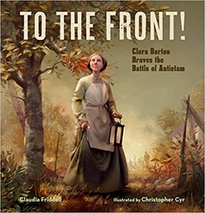
To the Front! Clara Barton Braves the Battle of Antietam. Claudia Friddell. Illustrated by Christopher Cyr. Calkins Creek, 2022. (2-6) Charity, Compassion, Women's History Month.
This riveting, new picture book fills a great void, bringing Clara Barton's nursing work to life in a new way. The Civil War's Battle of Antietam was America's bloodiest day. But there in the fray was newly commissioned Clara Barton and her male nursing team, whose work with the injured, wounded, and dying, earned Clara the nickname "Angel of the Battlefield." Barton was among the first women ever to be allowed on the battlefield, and the grit and danger are well described here. Simple poetic text and the book's powerful illustrations (contrasts of light, dark, and hope in the darkness) bring to life the courage and compassion needed to brave the frontlines of battle. Excerpts from Clara's own letters are the most powerful sections. Second to sixth graders will gain new understanding of the Civil War and the efforts that eventually led to the formation of the American Red Cross. An especially strong section of back matter fills in her biography for older students.
This riveting, new picture book fills a great void, bringing Clara Barton's nursing work to life in a new way. The Civil War's Battle of Antietam was America's bloodiest day. But there in the fray was newly commissioned Clara Barton and her male nursing team, whose work with the injured, wounded, and dying, earned Clara the nickname "Angel of the Battlefield." Barton was among the first women ever to be allowed on the battlefield, and the grit and danger are well described here. Simple poetic text and the book's powerful illustrations (contrasts of light, dark, and hope in the darkness) bring to life the courage and compassion needed to brave the frontlines of battle. Excerpts from Clara's own letters are the most powerful sections. Second to sixth graders will gain new understanding of the Civil War and the efforts that eventually led to the formation of the American Red Cross. An especially strong section of back matter fills in her biography for older students.
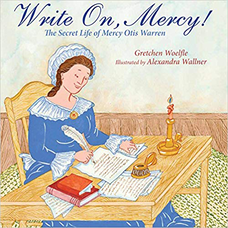
Write On, Mercy! The Secret Life of Mercy Otis Warren. Gretchen Woelfle. Illustrated by Alexandra Wallner. Calkins Creek, 2012. (2-6)
Who wrote the first nineteenth-century history of the American Revolution? A woman who lived it: Mercy Otis Warren. At a time when many women did not receive a strong education in the classics, she did, and Mercy Otis Warren had a life-long love of history, law, and the life of her young nation. The sister of firebrand patriot James Otis, and the wife of Dr. James Warren (who fought at Bunker Hill), she had ongoing exposure to the course of the war, and a strong desire to write about the issues of the day. This is a well written introduction to one of the Founding Mothers. Throughout her life, Mercy wrote satirical poetry, political plays, and in 1805 published a three-volume history of the American Revolution, which Jefferson lauded as a valuable contribution, though her Quincy-based neighbor, John Adams, disagreed. Refusing to limit her activities to the domestic sphere alone, Mercy bucked the trends of her time and gained many admirers. (She strained her friendship with John and Abigail Adams because on him, her history showed no mercy!)
Who wrote the first nineteenth-century history of the American Revolution? A woman who lived it: Mercy Otis Warren. At a time when many women did not receive a strong education in the classics, she did, and Mercy Otis Warren had a life-long love of history, law, and the life of her young nation. The sister of firebrand patriot James Otis, and the wife of Dr. James Warren (who fought at Bunker Hill), she had ongoing exposure to the course of the war, and a strong desire to write about the issues of the day. This is a well written introduction to one of the Founding Mothers. Throughout her life, Mercy wrote satirical poetry, political plays, and in 1805 published a three-volume history of the American Revolution, which Jefferson lauded as a valuable contribution, though her Quincy-based neighbor, John Adams, disagreed. Refusing to limit her activities to the domestic sphere alone, Mercy bucked the trends of her time and gained many admirers. (She strained her friendship with John and Abigail Adams because on him, her history showed no mercy!)
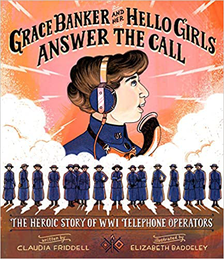
Grace Banker and Her Hello Girls Answer the Call: The Heroic Story of World War I Telephone Operators. Claudia Friddell. Illustrated by Elizabeth Baddeley. Calkins Creek, 2021. (2-5) Courage, Love of Country, Heroes
Illustrated in lively but lovely comic book style, this is the little known story of the first unit of women soldiers in World War I. Led by Grace Banker, the U.S. Army's Signal Corps sent the first unit of telephone operators into France, headed by Grace Banker. Fluent in French, Grace was a college-educated switchboard trainer in New York before the war. She used her skills on the battlefields in France, transmitting messages from commanders to battlefields and between American and French headquarters, and trying to keep high the spirits of the dough boys. She was the first and only woman operator to be awarded the Army's Distinguished Service Medal.
Illustrated in lively but lovely comic book style, this is the little known story of the first unit of women soldiers in World War I. Led by Grace Banker, the U.S. Army's Signal Corps sent the first unit of telephone operators into France, headed by Grace Banker. Fluent in French, Grace was a college-educated switchboard trainer in New York before the war. She used her skills on the battlefields in France, transmitting messages from commanders to battlefields and between American and French headquarters, and trying to keep high the spirits of the dough boys. She was the first and only woman operator to be awarded the Army's Distinguished Service Medal.
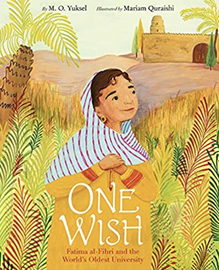
One Wish. Fatima al-Fihri and the World’s Oldest University. M.O. Yuksel. Illustrated by Mariam Quraishi. Harper Collins, 2022 (2-5) Perseverance, Love of Learning, Women's History Month
Born in Tunisia in the ninth century, Fatima al-Fihri had a lifelong passion for learning. Her family moved to Morocco during her childhood, where they became successful merchants. When both her husband and father died, Fatima's faith and love of knowledge prompted her to use the family's fortune to found a mosque, which became a university open to all. Lyrically written, this text reminds us of that extraordinary medieval women -- and Muslim women-- were also part of advancing the search for knowledge. (For second to fourth or fifth because of content and vocabulary.)
Born in Tunisia in the ninth century, Fatima al-Fihri had a lifelong passion for learning. Her family moved to Morocco during her childhood, where they became successful merchants. When both her husband and father died, Fatima's faith and love of knowledge prompted her to use the family's fortune to found a mosque, which became a university open to all. Lyrically written, this text reminds us of that extraordinary medieval women -- and Muslim women-- were also part of advancing the search for knowledge. (For second to fourth or fifth because of content and vocabulary.)
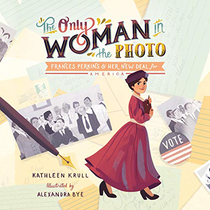
The Only Woman in the Photo: Frances Perkins & Her New Deal for America. Kathleen Krull. Illustrated by Alexandra Bye. Atheneum, 2020. (2-5) Lives to Learn From, Justice, Compassion
Krull brings to life the fascinating story of America's first female Cabinet secretary. Frances Perkins, who served as Secretary of Labor under Franklin Delano Roosevelt for twelve years, was a shy and compassionate child. Her best friend's family (Italian immigrant) was not as well off as her own, and when she saw suffering around her, she longed to help. Frances, who needed to be pushed to speak up, took to heart her grandmother's advice: "Speak up, when you see something wrong." and "When someone opens a door for you, walk through it." As a young woman, she worked in Jane Addams' settlement Houses in Chicago. She worked hard as FDR's Labor Secretary to eliminate child labor, improve workplace safety (especially after the Triangle Shirtwaiste factory fire), establish minimum wage laws, and pensions for the elderly. The author goes too far when she credits Frances Perkins as architect of the New Deal ("her New Deal") but she was the Irreplaceable Woman in the Cabinet and the only woman in the photo. Because of the content, it's a 2-5 pick.
Krull brings to life the fascinating story of America's first female Cabinet secretary. Frances Perkins, who served as Secretary of Labor under Franklin Delano Roosevelt for twelve years, was a shy and compassionate child. Her best friend's family (Italian immigrant) was not as well off as her own, and when she saw suffering around her, she longed to help. Frances, who needed to be pushed to speak up, took to heart her grandmother's advice: "Speak up, when you see something wrong." and "When someone opens a door for you, walk through it." As a young woman, she worked in Jane Addams' settlement Houses in Chicago. She worked hard as FDR's Labor Secretary to eliminate child labor, improve workplace safety (especially after the Triangle Shirtwaiste factory fire), establish minimum wage laws, and pensions for the elderly. The author goes too far when she credits Frances Perkins as architect of the New Deal ("her New Deal") but she was the Irreplaceable Woman in the Cabinet and the only woman in the photo. Because of the content, it's a 2-5 pick.
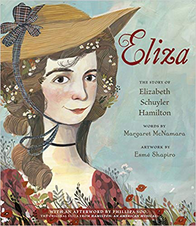
Eliza: The Story of Elizabeth Schuyler Hamilton.Margaret McNamara.
Illustrated by Esme Shapiro. Schwartz and Wade, 2018. (3-6)
Love of Country, Lives to Learn From
A rich introductory biography of one of the "Founding Mothers" told in first-person format. Eliza Hamilton, wife of Alexander Hamilton, takes the reader through the early years of the young republic, and her work alongside her husband (revolutionary era and beyond). Her efforts continued long after Alexander Hamilton's death in 1804. Eliza cared for his papers and legacy, but also established her own, helping to found the first orphanage in New York State and serving as its Director for twenty-seven years. In her lifetime, she met no fewer than 14 American presidents. (We get her first-person take on them: she didn't care for John Adams or Andrew Jackson.) Lively folk-art illustrations for this marvelous read-aloud (excellent through middle-school).
Illustrated by Esme Shapiro. Schwartz and Wade, 2018. (3-6)
Love of Country, Lives to Learn From
A rich introductory biography of one of the "Founding Mothers" told in first-person format. Eliza Hamilton, wife of Alexander Hamilton, takes the reader through the early years of the young republic, and her work alongside her husband (revolutionary era and beyond). Her efforts continued long after Alexander Hamilton's death in 1804. Eliza cared for his papers and legacy, but also established her own, helping to found the first orphanage in New York State and serving as its Director for twenty-seven years. In her lifetime, she met no fewer than 14 American presidents. (We get her first-person take on them: she didn't care for John Adams or Andrew Jackson.) Lively folk-art illustrations for this marvelous read-aloud (excellent through middle-school).
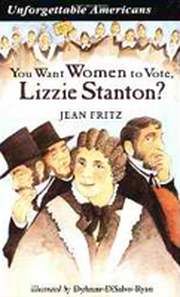
You Want Women to Vote, Lizzie Stanton? Jean Fritz.
Puffin, 1999. (3-6) Lives to Learn From
Another clear-eyed and playful biography from Fritz, accurately chronicling the life and times of Elizabeth Cady Stanton. Stanton’s work for women’s rights and women’s suffrage put her at the (rather rough) cutting edge of change in the early twentieth century. It will inspire young readers and educate all about women’s changing roles.
Puffin, 1999. (3-6) Lives to Learn From
Another clear-eyed and playful biography from Fritz, accurately chronicling the life and times of Elizabeth Cady Stanton. Stanton’s work for women’s rights and women’s suffrage put her at the (rather rough) cutting edge of change in the early twentieth century. It will inspire young readers and educate all about women’s changing roles.
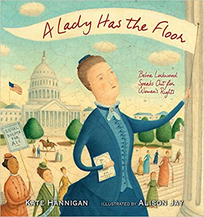
A Lady Has the Floor. Belva Lockwood Speaks Out For Women’s Rights. Kate Hannigan. Illustrated by Alison Jay. Calkins Creek, 2018. (3-6) Persistence, Women’s History Month
Belva Lockwood (1830 -1917) championed the underdog. In the 1840s she believed girls should be allowed to go to school, to hike, to skate, and earn college degrees. Belva taught in schools in New York state and then moved to Washington, where she earned a law degree. (She completed the courses, but the University wouldn't grant the degree because she was a woman. When she wrote to college president and U.S. President Ulysses S. Grant, he signed her degree and sent it to her.) Then Belva went on to be the first woman attorney to argue before the Supreme Court (1880). (She argued that an African-American attorney should be permitted to argue before the Supreme Court. And she won.) Lockwood agreed with Susan B. Anthony that women should have the right to vote, but she wanted women in office too. In 1884, she appeared on the ballot for President (but lost to Grover Cleveland). Unfortunately, Lockwood died before the nineteenth amendment (women’s suffrage) was passed, but she never stopped fighting for women, for African Americans, Native Americans, widows and veterans.
Belva Lockwood (1830 -1917) championed the underdog. In the 1840s she believed girls should be allowed to go to school, to hike, to skate, and earn college degrees. Belva taught in schools in New York state and then moved to Washington, where she earned a law degree. (She completed the courses, but the University wouldn't grant the degree because she was a woman. When she wrote to college president and U.S. President Ulysses S. Grant, he signed her degree and sent it to her.) Then Belva went on to be the first woman attorney to argue before the Supreme Court (1880). (She argued that an African-American attorney should be permitted to argue before the Supreme Court. And she won.) Lockwood agreed with Susan B. Anthony that women should have the right to vote, but she wanted women in office too. In 1884, she appeared on the ballot for President (but lost to Grover Cleveland). Unfortunately, Lockwood died before the nineteenth amendment (women’s suffrage) was passed, but she never stopped fighting for women, for African Americans, Native Americans, widows and veterans.
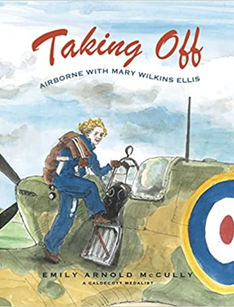
Taking Off: Airborne with Mary Wilkins Ellis. Emily Arnold McCully. Margaret Ferguson Books, 2022. (3-6) Perseverance, Courage, Love of Country, Women's History Month.
Mary Ellis had loved to fly from an early age, taking her first flight in 1925 at age eight. As soon as the young British girl was able (age 16), she got her pilot’s license. When the war broke out in Europe, Mary wanted to enlist and lend a hand. She joined the RAF as a transport pilot, ferrying new planes to the troops. She and her fellow women pilots were an integral part of the victory of the Allies. Her love of life and flying shine through in the airy watercolors.
Mary Ellis had loved to fly from an early age, taking her first flight in 1925 at age eight. As soon as the young British girl was able (age 16), she got her pilot’s license. When the war broke out in Europe, Mary wanted to enlist and lend a hand. She joined the RAF as a transport pilot, ferrying new planes to the troops. She and her fellow women pilots were an integral part of the victory of the Allies. Her love of life and flying shine through in the airy watercolors.
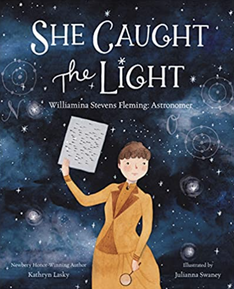
She Caught the Light. Kathryn Lasky. Illustrated by Julianna Swaney. HarperCollins, 2021. 3-6. Wonder, Diligence. The true story of the first American woman elected to honorary membership in the Royal Astronomical Society for her discovery of the Horsehead Nebula. From the time she was very young, Scottish-born Williamina Stevens Fleming (1857-1911) was curious and observant. She emigrated to America and became a maid in the home of Harvard astronomer, Edward Pickering, and kept asking her questions. Eventually Pickering (Director of the Harvard Observatory) realized that his maid had an aptitude for math and the study of stars. She hired her to replace one of his male assistants and she worked to catalog the spectra of stars recorded by the Observatory's telescope. She developed techniques of light analysis that helped her discover the composition of stars. As curator of Astronomical photographs, she was also the first woman to receive an official title from Harvard. Hard work, wonder, passion and perseverance combine in this book that will fascinate older elementary students.
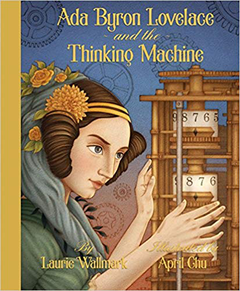
Ada Byron Lovelace and The Thinking Machine.* Laurie Wallmark.
Illustrated by April Ghu. Creston Books, 2015. (3-6)
Perseverance, Lives to Learn From
Beautifully written true story of the nineteenth century woman, who pioneered computer programming! Ada, the daughter of English poet Lord Byron and mathematically gifted Lady Byron (known as the "Princess of Parallelograms") grew up loving numbers. During a childhood illness she lost her sight, but her mother made sure blindness didn't prevent Ada from sharpening her mind with number puzzles. When Ada recovered, her mother hired a tutor to help her develop her mathematical gift. Ada met Charles Babbage, who recognized her genius and sought her help in developing his Analytical Engine. Ada developed the first program to run his "thinking machine" in 1843. This little-known heroine is brought to life by fine text and lush illustrations on every page.*Available on Epic!
Illustrated by April Ghu. Creston Books, 2015. (3-6)
Perseverance, Lives to Learn From
Beautifully written true story of the nineteenth century woman, who pioneered computer programming! Ada, the daughter of English poet Lord Byron and mathematically gifted Lady Byron (known as the "Princess of Parallelograms") grew up loving numbers. During a childhood illness she lost her sight, but her mother made sure blindness didn't prevent Ada from sharpening her mind with number puzzles. When Ada recovered, her mother hired a tutor to help her develop her mathematical gift. Ada met Charles Babbage, who recognized her genius and sought her help in developing his Analytical Engine. Ada developed the first program to run his "thinking machine" in 1843. This little-known heroine is brought to life by fine text and lush illustrations on every page.*Available on Epic!
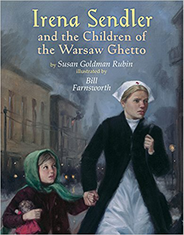
Irena Sendler and the Children of the Warsaw Ghetto. Susan Goldman Rubin. Illustrated by Bill Farnsworth. Holiday House, 2016.
(4-6) Lives to Learn From, Courage, Compassion, Mercy
An important older child’s book about a Polish Catholic social worker, who over three years smuggled more than 2500 Jewish children out of the Warsaw Ghetto to safety during World War II. Irena Sendler’s actions (combined with the selflessness of Jewish parents who let their children go) ensured that these children did not die in the Treblinka Concentration Camp, as most of their family members did. Irena was eventually apprehended by the Germans for her actions, imprisoned, and tortured. She survived but her thoughts remained with those she couldn’t save. This extraordinary story lay untold for many years, since the Communist regime that ruled Poland after the war considered her (she was anti-communist too) a traitor. The Jewish community remembered, and Irena herself had buried the names of the children she saved in jars in her yard. A haunting and extraordinary story of one woman, who remembered her father’s wisdom: “When someone is drowning, you don’t ask if they can swim. You jump in to save them.” The large picture book format should not be mistaken for a K-3 read. This is an older child’s book.
(4-6) Lives to Learn From, Courage, Compassion, Mercy
An important older child’s book about a Polish Catholic social worker, who over three years smuggled more than 2500 Jewish children out of the Warsaw Ghetto to safety during World War II. Irena Sendler’s actions (combined with the selflessness of Jewish parents who let their children go) ensured that these children did not die in the Treblinka Concentration Camp, as most of their family members did. Irena was eventually apprehended by the Germans for her actions, imprisoned, and tortured. She survived but her thoughts remained with those she couldn’t save. This extraordinary story lay untold for many years, since the Communist regime that ruled Poland after the war considered her (she was anti-communist too) a traitor. The Jewish community remembered, and Irena herself had buried the names of the children she saved in jars in her yard. A haunting and extraordinary story of one woman, who remembered her father’s wisdom: “When someone is drowning, you don’t ask if they can swim. You jump in to save them.” The large picture book format should not be mistaken for a K-3 read. This is an older child’s book.
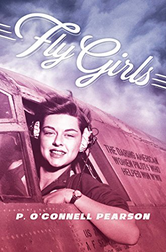
Fly Girls: The Daring American Women Pilots Who Helped Win WWII. Patricia O'Connell Pearson. Simon and Schuster, 2018. (5-6)
Who knew there were female pilots in World War II? Pearson's engaging account of the eleven hundred Women Airforce Service Pilots (WASP) of WW2 tells a little-known story. A number of women had learned to fly in the 1930s, some for sport and others for business. Now, as World War II raged, the U.S. government desperately needed more pilots. This gritty group stepped up to the plate, and sometimes found themselves teaching the "Fly Boys," but they were not allowed to fly in combat. Nonetheless, they were trained as military pilots, flew planes from factories to military bases, tested planes and equipment, schooled the flyboys, lived on base, and much more. This is a story of those who had the skill and will to serve, and made a difference, though not enjoying many of the benefits to which their expertise entitled them. This is a reflection on how far we've come, and those who paved the way.
Who knew there were female pilots in World War II? Pearson's engaging account of the eleven hundred Women Airforce Service Pilots (WASP) of WW2 tells a little-known story. A number of women had learned to fly in the 1930s, some for sport and others for business. Now, as World War II raged, the U.S. government desperately needed more pilots. This gritty group stepped up to the plate, and sometimes found themselves teaching the "Fly Boys," but they were not allowed to fly in combat. Nonetheless, they were trained as military pilots, flew planes from factories to military bases, tested planes and equipment, schooled the flyboys, lived on base, and much more. This is a story of those who had the skill and will to serve, and made a difference, though not enjoying many of the benefits to which their expertise entitled them. This is a reflection on how far we've come, and those who paved the way.
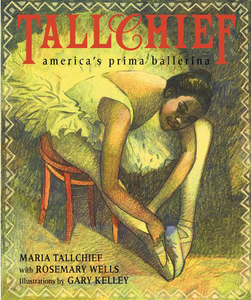
Tallchief: America’s Prima Ballerina. Maria Tallchief, Rosemary Wells. Illustrated by Gary Kelley
Puffin, 2001 (4-6) Wonder, Diligence, Grit, WHM
Poetically written (in the first person) and gorgeously illustrated, this is the poignant story of one of America’s greatest ballerinas. Raised on an Osage Indian reservation in Oklahoma (1925), Maria was born with music in her heart. As she matured, both piano and dance thrilled her. Though dancing was forbidden on the reservation, Maria’s parents recognized her gift and moved the family to California to help her realize her potential. She worked very hard under her new teacher. When the Ballet Russes came to Los Angeles, Maria knew that is what she wanted to do with her life. She left LA for New York and the world of ballet was forever richer. A wonderful story of a young woman following her heart, and achieving her dreams.
Puffin, 2001 (4-6) Wonder, Diligence, Grit, WHM
Poetically written (in the first person) and gorgeously illustrated, this is the poignant story of one of America’s greatest ballerinas. Raised on an Osage Indian reservation in Oklahoma (1925), Maria was born with music in her heart. As she matured, both piano and dance thrilled her. Though dancing was forbidden on the reservation, Maria’s parents recognized her gift and moved the family to California to help her realize her potential. She worked very hard under her new teacher. When the Ballet Russes came to Los Angeles, Maria knew that is what she wanted to do with her life. She left LA for New York and the world of ballet was forever richer. A wonderful story of a young woman following her heart, and achieving her dreams.
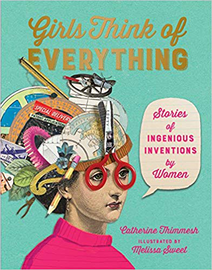
Girls Think of Everything. Stories of Ingenious Inventions by Women.
Catherine Thimmesh. Illustrated by Melissa Sweet. HMH, 2018.(4-6)
Necessity may be the mother of invention, but plenty of mothers have become inventors along the way. These are the stories of 15 women and their search for a better way to do something that makes the world a better place to live in. From Chocolate chips to Kevlar, paper bags to Space Bumpers, the women in this book, tried again and again to think of and produce a new way to solve old problems. Inspiring stories and fun illustrations.
Catherine Thimmesh. Illustrated by Melissa Sweet. HMH, 2018.(4-6)
Necessity may be the mother of invention, but plenty of mothers have become inventors along the way. These are the stories of 15 women and their search for a better way to do something that makes the world a better place to live in. From Chocolate chips to Kevlar, paper bags to Space Bumpers, the women in this book, tried again and again to think of and produce a new way to solve old problems. Inspiring stories and fun illustrations.

